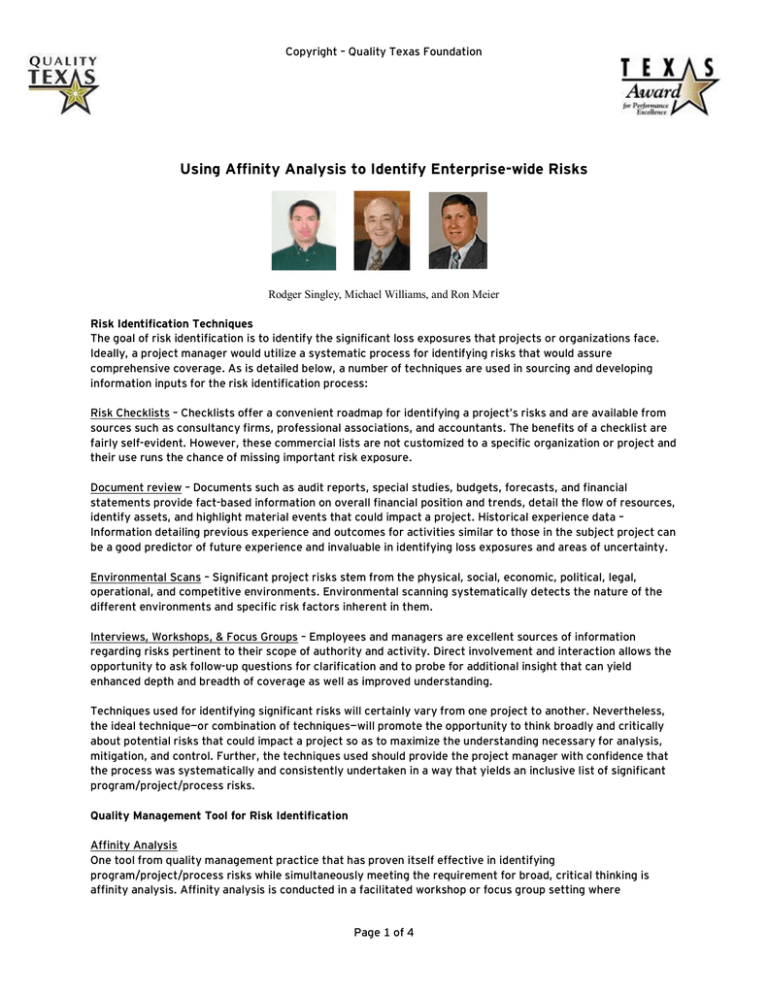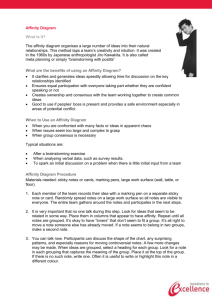Using Affinity Analysis To Identify Risk
advertisement

Copyright – Quality Texas Foundation Using Affinity Analysis to Identify Enterprise-wide Risks Rodger Singley, Michael Williams, and Ron Meier Risk Identification Techniques The goal of risk identification is to identify the significant loss exposures that projects or organizations face. Ideally, a project manager would utilize a systematic process for identifying risks that would assure comprehensive coverage. As is detailed below, a number of techniques are used in sourcing and developing information inputs for the risk identification process: Risk Checklists – Checklists offer a convenient roadmap for identifying a project’s risks and are available from sources such as consultancy firms, professional associations, and accountants. The benefits of a checklist are fairly self-evident. However, these commercial lists are not customized to a specific organization or project and their use runs the chance of missing important risk exposure. Document review – Documents such as audit reports, special studies, budgets, forecasts, and financial statements provide fact-based information on overall financial position and trends, detail the flow of resources, identify assets, and highlight material events that could impact a project. Historical experience data – Information detailing previous experience and outcomes for activities similar to those in the subject project can be a good predictor of future experience and invaluable in identifying loss exposures and areas of uncertainty. Environmental Scans – Significant project risks stem from the physical, social, economic, political, legal, operational, and competitive environments. Environmental scanning systematically detects the nature of the different environments and specific risk factors inherent in them. Interviews, Workshops, & Focus Groups – Employees and managers are excellent sources of information regarding risks pertinent to their scope of authority and activity. Direct involvement and interaction allows the opportunity to ask follow-up questions for clarification and to probe for additional insight that can yield enhanced depth and breadth of coverage as well as improved understanding. Techniques used for identifying significant risks will certainly vary from one project to another. Nevertheless, the ideal technique—or combination of techniques—will promote the opportunity to think broadly and critically about potential risks that could impact a project so as to maximize the understanding necessary for analysis, mitigation, and control. Further, the techniques used should provide the project manager with confidence that the process was systematically and consistently undertaken in a way that yields an inclusive list of significant program/project/process risks. Quality Management Tool for Risk Identification Affinity Analysis One tool from quality management practice that has proven itself effective in identifying program/project/process risks while simultaneously meeting the requirement for broad, critical thinking is affinity analysis. Affinity analysis is conducted in a facilitated workshop or focus group setting where Page 1 of 4 Copyright – Quality Texas Foundation knowledgeable persons complete an iterative process in which a large number of ideas are generated and then sorted by the participants into categories to form topical content groupings. Subsequent idea generation and sorting are then undertaken to further flesh out each of the previously established groups and to generate tree diagrams depicting the hierarchical relationship of each category with the content comprising each of the more macro categories. The strength of affinity analysis in identifying risks stems from its integration of each of the above techniques for risk identification into one very deliberate and seamless process. Affinity analysis immerses participants in a systematic process which integrates their divergent thinking with convergent thinking. Divergent thinking is unrestricted idea generation based on each individual’s unshared expertise in the project area, knowledge of historical experiences and related documents, and familiarity with the various environments with potential for impacting the project. Unlike conventional brainstorming techniques, idea generation in affinity analysis is not a shared process. Each participant generates their own series of items based on their own individual knowledge and understanding—unimpeded by the thoughts, opinions, and comments of others. There is no perceived personal risk or group think at this point which better assures the generation of a comprehensive listing of items. Convergent thinking begins with pooling together all the ideas from each participant. Duplicates are then eliminated. This is followed by participants working together as a group in collaborative consideration and discussion of each individual risk item. Through the integration and pooling of all the expertise of participants, individual items are edited for clarity, vetted for relevance and significance to the project, and then grouped into categories. In a second phase of convergent thinking, the group considers each category—one category at a time—and looks for possible gaps, missing risks that are then added to the category to result in a thoroughly considered and complete list of relevant program/project/process risks. The individual risk items comprising each category are synonymous with the idea of a check-list of significant risks. However, unlike the generic, standardized risk check-lists discussed above, this risk list offers the advantage of being generated for and customized to the specific project being managed. When it is formatted into its family of categories and macro-categories, the listing provides the project manager with a comprehensive taxonomy of risks specific to the project. An Illustrative Example Employing Affinity Analysis In an actual application of affinity analysis to identify the risks relevant to a technology expansion project for a global financial services organization, a group of seven individuals with expertise on different areas of the project were brought together for a facilitated workshop with the project manager serving as a moderator. Some of these participants were executives and managers while others were lower level employees in the organization. Others in the group were from outside the organization. The common thread among all participants was a working knowledge and familiarity with the various facets of and activities comprising the project. After a short briefing on the project, its goals, and activities, each participant was given several pads of sticky notes and a felt tip pen (notes should be large enough and pens dark enough to read written comments from a short distance). They were then instructed to write down all the risks they could think of that could possibly face the project—one risk per sticky note sheet. Each participant then proceeded to generate as many items as possible in the timed period of fifteen minutes. A total of 203 risks were initially recorded onto sticky notes. Participants placed their sticky notes on a large open wall providing an explanation of each risk as it was placed onto the wall. Duplicates and items deemed non-relevant were eliminated at this phase of the process producing a set of 133 risk items. Subsequent sorting of the risks into related categories was accomplished by moving the sticky notes and placing them into groupings on the wall. This sorting process and its related discussion resulted in 22 categories labled with a descriptive name based on its content. Subsequent sorting and discussion yielded four macro-categories as family groupings of the original 22 categories. Page 2 of 4 Copyright – Quality Texas Foundation Figure 1 illustrates the taxonomy, its four main categories of risk, and their respective 22 sub-categories. Figure 1. Highest level of risk taxonomy: Categories and sub-categories. Each category was then examined for missing risks resulting in 21 additional risks and producing a final set of 154 risks identified as relevant to this project. Figure 2 depicts some of the individual risks in the technology category. Page 3 of 4 Copyright – Quality Texas Foundation Figure 2. Individual technology risks Summary One of the first steps in developing a project plan is the identification of potential risks that may impact the project schedule, budget, or level of customer satisfaction. Risks are best identified through a process that utilizes all project team members’ individual expertise in order to assure a comprehensive listing of all pertinent risks. Due to its integration of divergent and convergent thinking, affinity analysis has proven to be a highly effective tool for the development of project risk taxonomies. Through affinity analysis we are able to organize and illustrate linkages amongst the various categories, subcategories and individual risks specific to the project. The next article in this series will focus on how individual risks are qualitatively and quantitatively assessed to aid project managers in their development of optimistic and pessimistic scheduling and budgeting parameters. Page 4 of 4

